Fig.1

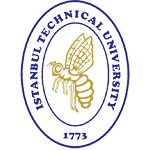
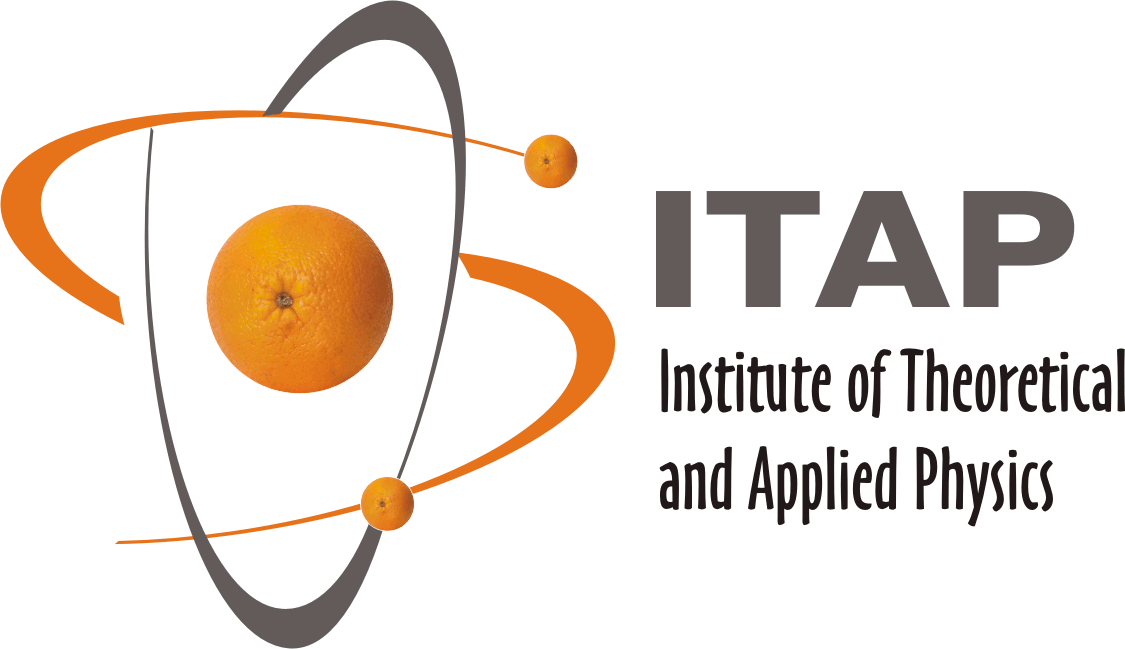
In Dirac materials with strong spin-orbit coupling, the spin aligns orthogonally to the momentum in the vicinity of the Dirac point (DP) (Fig.1 and Fig.2) -a phenomenon often termed a spin-momentum locking and verified experimentally. Deviations from the orthogonal spin-momentum locking has been observed since 2011 in a number of three dimensional topological insulators and most recently in 2018 in Dirac semimetals. We investigate the sources of these anomalies focusing on the experimentally observed interactions in the topological surface states.
In our two recent works Ref.[1] and Ref.[2], we proposed that, interactions in the presence of spin-orbit coupling and anisotropy, can lead to anomalous deviations in the spin texture beyond the perpendicular spin-momentum locking. Our results are summarized in Fig.3-5 below.

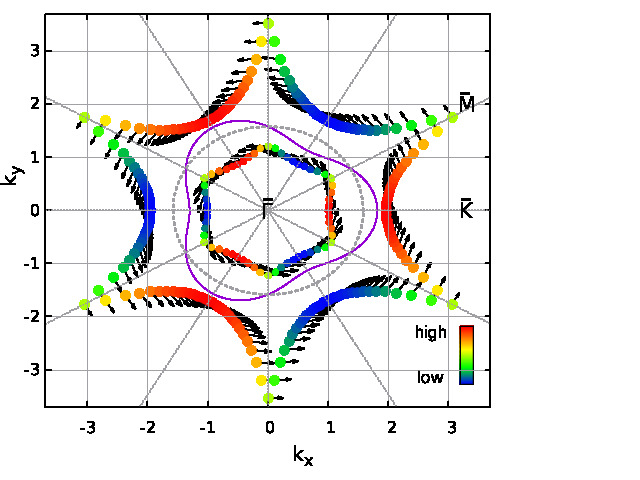

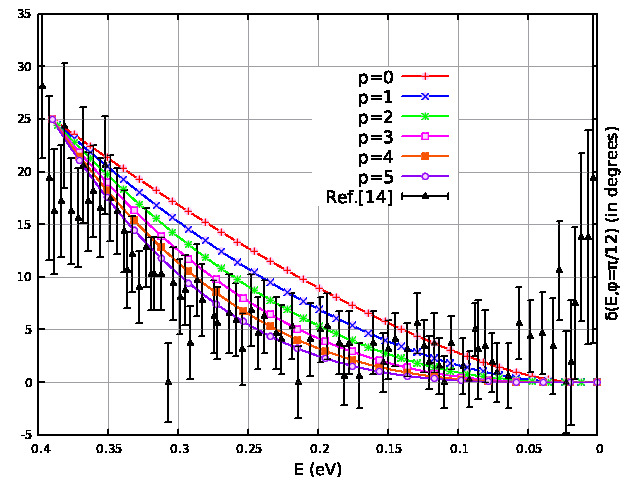
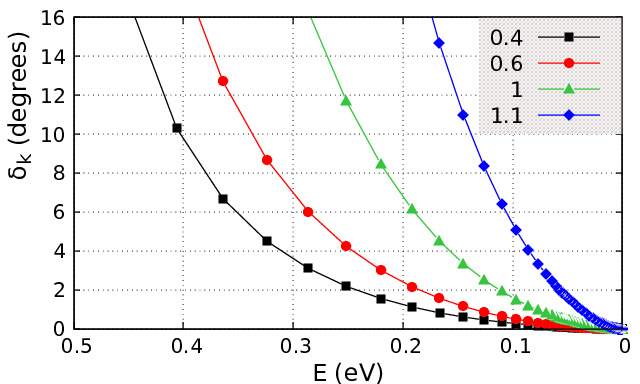
Fig.1: The hexagonally warped spin texture of the surface state in $Bi_2 Se_3$ predicted by the independent particle level.
Fig.2: According to the independent particle model, the spin-momentum pair is perpendicularly locked in the surface state in $Bi_2 Se_3$ in the presence of hexagonal warping anisotropy.
Fig.3: Our initial work in Ref.[2] modified the picture in Fig.'s [1] and [2]. Interactions modify the the perpendicular spin-momentum locking. In hexagonally warped $Bi_2 Se_3$, the in-plane spin-texture ${\boldsymbol S}({\boldsymbol k})$ is renormalized by the electron self-energy (from Ref.[2]). The plane spin anomaly was initially observed in Ref.[3] and the out-of-plane one was measured in Ref.[4].
Fig.4: The data shows the spin-deviation angle as a measure of the radial spin component. The calculation is from Ref.[1]
Fig.5: The spin-deviation angle calculated from the self-energy in the interacting model of Ref.[2]
Recently we observed that, interactions also lead to spin-texture anomalies in Dirac semimetals. Our ongoing work in [6] explains the non-orthogonal isotropic spin-momentum locking in $\alpha-Sn$ and currently is the only theoretical explanation for the measured spin anomaly (Ref.[5]) in $\alpha-Sn$ due to the electron-impurity interaction.
References:
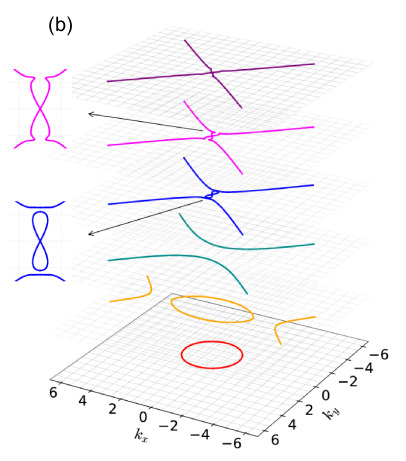
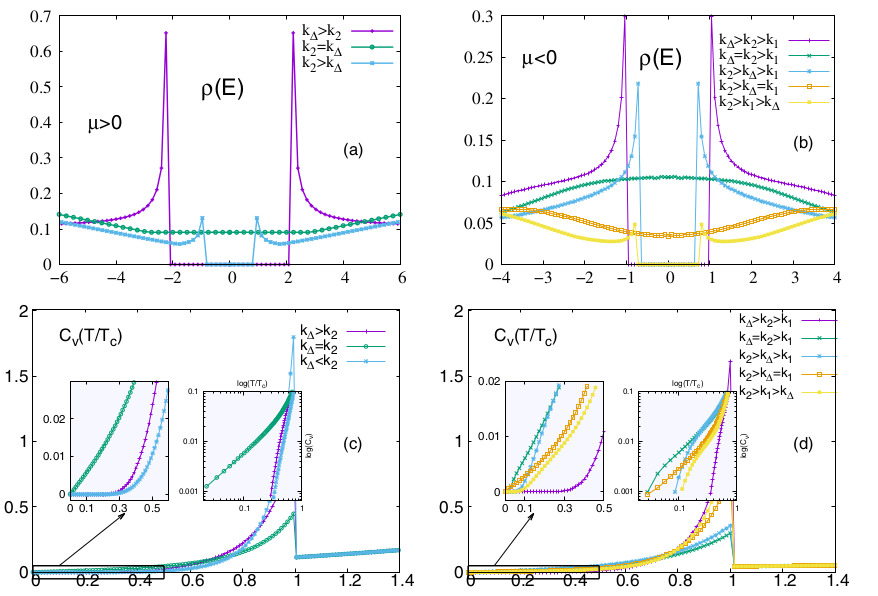
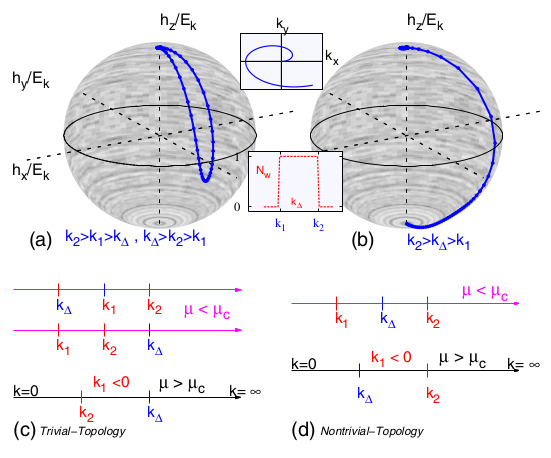
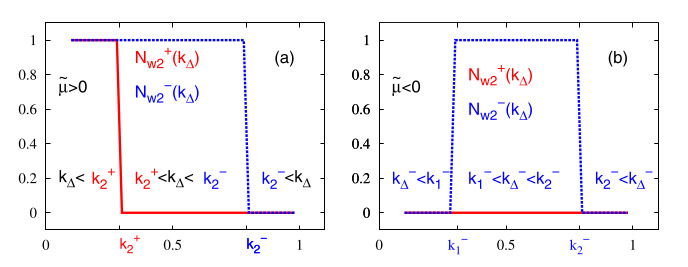
Fig.1 : Transformation of a pure radial line node into an open angular node of the pair potential $\Delta({\boldsymbol k})$.
Fig.2 : The mixed parity topological superconductors display a BCS like differential conductivity $dI/dV$ and the specific heat $C_v(T)$.
Fig.3: The topology of the trivial and non-trivial radial line node structure in NCS is determined by a $Z_2$ index. The topology is determined by the Fermi level crossings $k_{1,2}$ of the radial line node $k_\Delta$ of the pair potential. The possible configurations vary depending on the position of the Fermi level with respect to the Dirac point.
Fig.4: The $Z_2$ index in Fig.3 according to the relative position of the RLN with respect to the Fermi surface. The sharp transitions correspond to different topologies also indicated in Fig.3.
Phase-II: (Superconducting phase) A pure 2D superconductivity was discovered in single layers of $M X_2$ where $M$ is a transition metal and $X$ is a chalcogenic atom. Single layer of $Mo S_2$ and $Nb Se_2$ has no inversion symmetry whereas the even number of layers does. Depending on the number of layers, the superconductivity in this compound shows new unconventional features. We spend our efforts in understanding the nature of the superconducting pairing in this compound. The bulk $NbSe_2$ has the same crystal symmetry as the $Bi_2Se_3$ type topological insulators which has been found only recently to be superconducting at $T_c=7 K$. As the number of layers is reduced, at the monolayer limit the CDW is strengthened with $T_{CDW}\simeq 145 K$ whereas the superconductivity is weakened with $T_c\simeq 1.5 K$. Below $T_c$, the strong out-of-plane Ising spin-orbit coupling prefers Cooper pairs to quantize the spin along the same axis (Ising Superconductor). We spend effort in constructing the basic microscopic theory with the right normal state properties and the pairing correlations to understand the coexistence of unconventional superconductivity and unconventional CDW in this compound.
References:
Anisotropy plays a special role in unconventional as well as topological superconductors. The time reversal symmetry restricts the order parameter and the latter is not always happy about the point group symmetry of the underlying crystal. In result of of the two fundamental symmetries is broken. In tetragonal systems like $Sr_2 Ru O_4$ the time reversal symmetry is believed to be broken in the order parameter. The superconductors obtained from ${\bf Bi}_2{\bf Se}_3$ family by $Cu, Sr, Nb$ doping prefer a broken crystal rotational symmetry in the order parameter. The order parameter spontaneously chooses one of the equivalent orientations set by the point group symmetry much like a Heisenberg ferromagnet choosing a spontaneous axis of magnetization. This leads to the breaking of the rotational symmetry of the order parameter. In our ongoing work, we examine the effect of the anomalous spin orientation, that we understood in Ref.'s[1] and [2] of research field A, on the triplet-pairing ${\boldsymbol d}({\boldsymbol k})$ of the nematic superconductors.
Previous Research ($\le$ 2016): Exciton Condensation in Semiconductor Quantum Wells
Our other works related to Exciton Condensation:
New course: Solid State and Condensed Matter Physics - II ( Spring 2024 )
Solid State and Condensed Matter Physics - I ( Spring 2023 )
New offer for the Spring 2022: Theoretical and Computational Methods in the Physics of Materials - I
Quantum optoelectronics and optomechanics
Solid State Technologies from Quantum Mechanics to Quantum Engineering
Professor of Physics and Renewable Energy e-mail: hakioglu ~at~ itu.edu.tr tel: +90 (212) 285 3885
Energy Institute and Department of Physics, Istanbul Technical University
Maslak, 34469, Istanbul,
and the Director of
Institute of Theoretical and Applied Physics(ITAP)